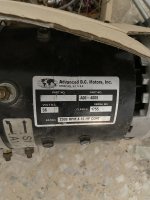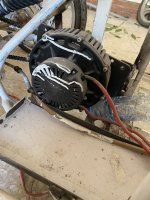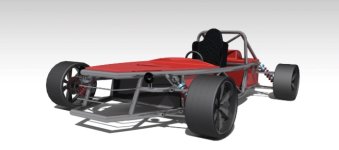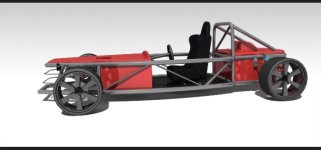You are using an out of date browser. It may not display this or other websites correctly.
You should upgrade or use an alternative browser.
You should upgrade or use an alternative browser.
Help identifying these two motors.
- Thread starter Fabulut
- Start date
jetpackjbd
100 W
First one appears to be a 36V Brushed EZ-GO golf cart motor from what I gather online. Here’s a thread from another forum discussing similar motors: A1, A2, S1, S2, question

If I understand correctly, A1 is positive and S2 is negative. Reverse by connecting A2 and S2 together and connect a negative to S1 although I’m not really sure how that works. Only familiar with two pin motors where you just reverse the polarity for the opposite direction of rotation (which you might be able to do for this one too?)
You should be able to control it with just a standard PWM controller rated for a ton of amps, probably want to use an old golf cart controller as they’re going to give the same performance (usually) and be cheaper used.
I found the motor for sale on multiple sites, here’s one.
Not sure about the second one, if you could provide more pics or find labels on it that would be appreciated!

If I understand correctly, A1 is positive and S2 is negative. Reverse by connecting A2 and S2 together and connect a negative to S1 although I’m not really sure how that works. Only familiar with two pin motors where you just reverse the polarity for the opposite direction of rotation (which you might be able to do for this one too?)
You should be able to control it with just a standard PWM controller rated for a ton of amps, probably want to use an old golf cart controller as they’re going to give the same performance (usually) and be cheaper used.
I found the motor for sale on multiple sites, here’s one.
Not sure about the second one, if you could provide more pics or find labels on it that would be appreciated!
A-DamW
100 W
Thanks a lot,First one appears to be a 36V Brushed EZ-GO golf cart motor from what I gather online. Here’s a thread from another forum discussing similar motors: A1, A2, S1, S2, question
View attachment 343000
If I understand correctly, A1 is positive and S2 is negative. Reverse by connecting A2 and S2 together and connect a negative to S1 although I’m not really sure how that works. Only familiar with two pin motors where you just reverse the polarity for the opposite direction of rotation (which you might be able to do for this one too?)
You should be able to control it with just a standard PWM controller rated for a ton of amps, probably want to use an old golf cart controller as they’re going to give the same performance (usually) and be cheaper used.
I found the motor for sale on multiple sites, here’s one.
Not sure about the second one, if you could provide more pics or find labels on it that would be appreciated!
Can I control these motors with a controller like this
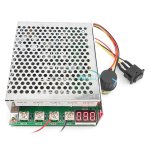
100a motor controller
or would I need a more advanced controllers like this
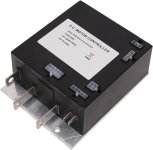
golf cart motor contoller
Thanks a lot,
Is there a special controller for this Perm PMG-132 motor, or is it possible to control with a cheap conroller like this
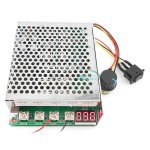
100a motor controller
Chalo
100 TW
I don't know what makes the "more advanced" controller more advanced. Those are two wire DC motors and you can run them straight from a battery if you want, with a naked wire as a throttle. There's no need to overthink things.
I was thinking like amp wise. will 100amps be enough to run these motors? because golf cart controller was like 275 - 300 amps.I don't know what makes the "more advanced" controller more advanced. Those are two wire DC motors and you can run them straight from a battery if you want, with a naked wire as a throttle. There's no need to overthink things.
Chalo
100 TW
How much power do you want? How much can your battery provide, how much are the motors rated for? These are your questions to answer.I was thinking like amp wise. will 100amps be enough to run these motors? because golf cart controller was like 275 - 300 amps.
I want to build a single seated exo car, total wheight probably be 100-150 kgs, I have nine 20ah batteries, and the motor I want to use is Perm PMG-132, which has 3,5 KW power for 110 amps and 36 V. If I connect the batteries 3 by 3, I would get about 36 volts and 60 ampers, I am in Turkey and I cannot get these high end controllers easily. I am looking for a controller that works nothing fancy.How much power do you want? How much can your battery provide, how much are the motors rated for? These are your questions to answer.
Chalo
100 TW
36V x 60Ah = a little over 2kWh. Plenty of juice.
The question is how much current (amperes) your batteries will support, three in parallel. What kind are they? Lead, lithium ion, or something else? If they're lead, they'll support as many amps as you demand, but with lots of voltage sag and lots of energy wasted. So less current is better if you need range.
EDIT:
By "exo car" do you mean an automobile that's been cut down to the floor pan and welded onto a roll cage? Because if so, you don't have a useful amount of battery to work with. You will need all the controller power you can get, plus several times as much battery as you say you have (unless it's radio control model lithium polymer batteries).
The question is how much current (amperes) your batteries will support, three in parallel. What kind are they? Lead, lithium ion, or something else? If they're lead, they'll support as many amps as you demand, but with lots of voltage sag and lots of energy wasted. So less current is better if you need range.
EDIT:
By "exo car" do you mean an automobile that's been cut down to the floor pan and welded onto a roll cage? Because if so, you don't have a useful amount of battery to work with. You will need all the controller power you can get, plus several times as much battery as you say you have (unless it's radio control model lithium polymer batteries).
Those are serious motors. I would love to try those. 
I would not go with a cheap controller. I believe the top motor id brush. Not sure about the lower but if only two motor wires and no sensor wires it is most likely a brush.
If it were me I would go with a Kelly controller.
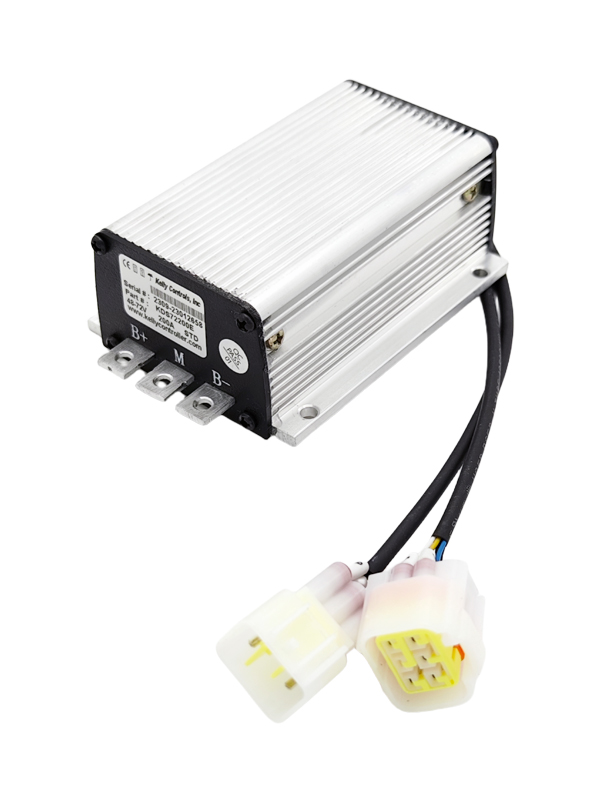
 kellycontroller.com
kellycontroller.com
They are fully programmable so can get a smooth safer start and operation. You have some really scary motors there so a Kelly controller can do a better job to tame the beast. I think that would be much safer then some of the controllers listed above.
Please do not take my word for it though as I am not allowed to give advice here. ust ask the other members what they think about Kelly controllers. I would order one but that is me. They are not really that expensive either for a quality name brand controller and the company has been around a very long time.
As far as the battery I use LIFEPO4 packs made from A123 cells. If you have a friend or are handy with a spot welder a 13S - 8P 43V pack is doable with an 80 or 100 amp Bluetooth BMS. I run 13S LIFEPO4 which is 43 working volts for 36V motors and 16 or 17S for 48V controllers.. I am developing a non weld or solder less kit where only the power wires need solder. All series connections will be solder less.
However until I get a 3D painter my idea is just an idea in the engineering stage so you are better off ordering a factory built LIFEPO4 pack or finding someone or learning how to spot weld a pack yourself.
Make sure you put fuses in. You can never be too carful. You can actually use two fuses. One for hot and a second for ground. Just be very carful if assembling a pack yourself. I am not advising you to do ANYTHING. , However if you do look at you tube videos showing how it is done from start to finish and don't hurt to watch it over several times.
The last thing you want is a cheap no name brand 18650 Lion pack. They can catch on fire. At least a name brand like Samsung (if genuine ) will have some cell protection circuit built in the top of the cells. FAKE Chinese cells do not so BEWARE.
I myself like Bluetooth and want to monitor cell voltage all the time. , during the charging and discharge cycle. I never leave the job to be done with a BMS active balancer NON Bluetooth. I do not trust it. If the BMS is not Bluetooth a separate balance plug and an external balancer can work to make dam sure the BMS is doing its job.
Good luck.
Skyler out.
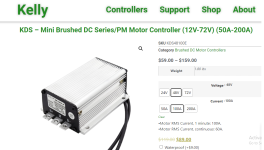
Thanks.
Skyler.
I would not go with a cheap controller. I believe the top motor id brush. Not sure about the lower but if only two motor wires and no sensor wires it is most likely a brush.
If it were me I would go with a Kelly controller.

KDS/KDM -Mini Brushed DC Series/PM Motor Controller (24V-72V) (50A-550A) - Kelly Controls
To see connectors' detailed dimensions,click here .
 kellycontroller.com
kellycontroller.com
They are fully programmable so can get a smooth safer start and operation. You have some really scary motors there so a Kelly controller can do a better job to tame the beast. I think that would be much safer then some of the controllers listed above.
Please do not take my word for it though as I am not allowed to give advice here. ust ask the other members what they think about Kelly controllers. I would order one but that is me. They are not really that expensive either for a quality name brand controller and the company has been around a very long time.
As far as the battery I use LIFEPO4 packs made from A123 cells. If you have a friend or are handy with a spot welder a 13S - 8P 43V pack is doable with an 80 or 100 amp Bluetooth BMS. I run 13S LIFEPO4 which is 43 working volts for 36V motors and 16 or 17S for 48V controllers.. I am developing a non weld or solder less kit where only the power wires need solder. All series connections will be solder less.
However until I get a 3D painter my idea is just an idea in the engineering stage so you are better off ordering a factory built LIFEPO4 pack or finding someone or learning how to spot weld a pack yourself.
Make sure you put fuses in. You can never be too carful. You can actually use two fuses. One for hot and a second for ground. Just be very carful if assembling a pack yourself. I am not advising you to do ANYTHING. , However if you do look at you tube videos showing how it is done from start to finish and don't hurt to watch it over several times.
The last thing you want is a cheap no name brand 18650 Lion pack. They can catch on fire. At least a name brand like Samsung (if genuine ) will have some cell protection circuit built in the top of the cells. FAKE Chinese cells do not so BEWARE.
I myself like Bluetooth and want to monitor cell voltage all the time. , during the charging and discharge cycle. I never leave the job to be done with a BMS active balancer NON Bluetooth. I do not trust it. If the BMS is not Bluetooth a separate balance plug and an external balancer can work to make dam sure the BMS is doing its job.
Good luck.
Skyler out.

Thanks.
Skyler.
Last edited:
Thanks a lot for the tips.Those are serious motors. I would love to try those.
I would not go with a cheap controller. I believe the top motor id brush. Not sure about the lower but if only two motor wires and no sensor wires it is most likely a brush.
If it were me I would go with a Kelly controller.

KDS/KDM -Mini Brushed DC Series/PM Motor Controller (24V-72V) (50A-550A) - Kelly Controls
To see connectors' detailed dimensions,click here .kellycontroller.com
They are fully programmable so can get a smooth safer start and operation. You have some really scary motors there so a Kelly controller can do a better job to tame the beast. I think that would be much safer then some of the controllers listed above.
Please do not take my word for it though as I am not allowed to give advice here. ust ask the other members what they think about Kelly controllers. I would order one but that is me. They are not really that expensive either for a quality name brand controller and the company has been around a very long time.
As far as the battery I use LIFEPO4 packs made from A123 cells. If you have a friend or are handy with a spot welder a 13S - 8P 43V pack is doable with an 80 or 100 amp Bluetooth BMS. I run 13S LIFEPO4 which is 43 working volts for 36V motors and 16 or 17S for 48V controllers.. I am developing a non weld or solder less kit where only the power wires need solder. All series connections will be solder less.
However until I get a 3D painter my idea is just an idea in the engineering stage so you are better off ordering a factory built LIFEPO4 pack or finding someone or learning how to spot weld a pack yourself.
Make sure you put fuses in. You can never be too carful. You can actually use two fuses. One for hot and a second for ground. Just be very carful if assembling a pack yourself. I am not advising you to do ANYTHING. , However if you do look at you tube videos showing how it is done from start to finish and don't hurt to watch it over several times.
The last thing you want is a cheap no name brand 18650 Lion pack. They can catch on fire. At least a name brand like Samsung (if genuine ) will have some cell protection circuit built in the top of the cells. FAKE Chinese cells do not so BEWARE.
I myself like Bluetooth and want to monitor cell voltage all the time. , during the charging and discharge cycle. I never leave the job to be done with a BMS active balancer NON Bluetooth. I do not trust it. If the BMS is not Bluetooth a separate balance plug and an external balancer can work to make dam sure the BMS is doing its job.
Good luck.
Skyler out.
View attachment 343011
Thanks.
Skyler.
Since I am in Turkey it is hard for me to get controllers like these. Most of them come from the US and there will be a customs issue. I will try to find similar controllers locally.
I have only the motors and first thing I want to do is get a motor controller powerful enough to run them after that I will try to find suitable battery and also I need to build frame.
The frame I want to build is similar to this. I wish someday I can post the finished car.
Thanks for your help
Best
Fatih
Attachments
eee291
100 kW
You can get Curtis clone controllers like this one for cheap.
These aren't really the best motors for lightweight cars.
Brushed motors weigh a ton and have terrible torque especially of you're just planning on using 2.5kw.
For instance, I have a city El with a original brushed motor and that thing is geared for 50kmh and barely accelerates as well as a 50cc scooter even though it is pulling close to 6kw from the battery!
The first picture is a series wound motor, current passes from the armature to the field in series. So you would need to connect A1 to S1 and A2 and S2 to your controller. The problem is that you can't reverse a motor like this without reversing contactors.
I solved this problem using two controllers instead of contactors. At least one of the controllers needs to have a reversing function for this to work! Like a Kelly or other reversible brushed controller.
The second motor would be my choice.
It probably weighs 1/3 compared to the first one and It can be run on 72v @100A at 3500 rpm, it has a better toque band. You could get away with using 16mm² wires. Only issue is a 72v brushed controller with reverse function is not cheap compared to a 36v one.
You could also build your own controller from a EV/Hybrid inverter, like a Honda civic powerstage or something similar.
These aren't really the best motors for lightweight cars.
Brushed motors weigh a ton and have terrible torque especially of you're just planning on using 2.5kw.
For instance, I have a city El with a original brushed motor and that thing is geared for 50kmh and barely accelerates as well as a 50cc scooter even though it is pulling close to 6kw from the battery!
The first picture is a series wound motor, current passes from the armature to the field in series. So you would need to connect A1 to S1 and A2 and S2 to your controller. The problem is that you can't reverse a motor like this without reversing contactors.
I solved this problem using two controllers instead of contactors. At least one of the controllers needs to have a reversing function for this to work! Like a Kelly or other reversible brushed controller.
The second motor would be my choice.
It probably weighs 1/3 compared to the first one and It can be run on 72v @100A at 3500 rpm, it has a better toque band. You could get away with using 16mm² wires. Only issue is a 72v brushed controller with reverse function is not cheap compared to a 36v one.
You could also build your own controller from a EV/Hybrid inverter, like a Honda civic powerstage or something similar.
Similar threads
- Replies
- 8
- Views
- 211
- Replies
- 4
- Views
- 215
- Replies
- 9
- Views
- 276


